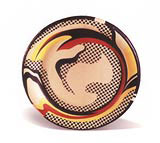Extraordinary
Modern artists are usually famed for enduring, one-off pieces, but a show at the ICA is focusing on mass-produced ephemera. Martin Carty takes the tour

London’s Institute of Contemporary Art’s Extra Art show, subtitled A Survey of Artists’ Ephemera, 1960-1999 is a diverse exhibition of 500 printed works by 190 different artists. The ephemera on show includes exhibition invitations, postcards, advertisements, posters, publications, beer mats and bookmarks by an impressive list of artists, such as Barbara Kruger, Joseph Beuys, Lawrence Weiner and Edward Ruscha.
As designers we see our ephemeral work, (posters for an event which has finished or last year’s corporate report), as still having great importance. They are included in our portfolios, they still represent us and are part of our body of work.
For the artist these pieces are seen differently. Usually an artist’s work is unique: a valuable, timeless one-off, exhibited in a gallery. However, the artists’ creations in Extra Art are mass-produced and often given away for free, which often leads to them being placed outside the realm of art as defined by art galleries. They are rarely taken seriously by the dealers and collectors of the art world. After all, how do you value something with apparently so little value?
The many works in the exhibition are produced for a range of different reasons. Often they announce an occasion. Whereas normally works of art are considered timeless, these are intended for a specific date. In 1990, Ian Hamilton Finlay sent his friends a poetic-word, art Christmas card with the lines: ‘potatocut robin’; ‘linocut garden fork’; ‘wood-engraved tree’, printed on white card.
Often the occasion announced is the artist’s own show. For a 1960 exhibition in Paris, artist Arman filled a gallery with rubbish and as invitations, he mailed out 500 old sardine cans stuffed with scraps. The cans were labelled ‘open before 25 October 1960’ the date when the exhibition finished. A refreshing change from the gallery-branded invitations we see today.
Often the work forms announcements for a performance by the artist. In 1969, Jan Dibbets sent out a postcard indicating the time and place where he would be making a certain gesture: in this case, thumbs-up and winking. As in many other cases of performance announcements, the cards become the artist’s only record of the idea.
Some artists have used magazine advertising as a way to show their work. Stephen Kaltenbach placed monthly statements in the classified section of Artforum: ‘Teach Art’, ‘Tell a Lie’ and so on. In November 1988 Jeff Koons took out full-page, colour ads for himself in four different art magazines. Again, this work is neither timeless nor unique.
Use of advertising methods doesn’t always go according to plan. In 1987, the collective General Idea produced an Aids-awareness poster. For the poster they reproduced a seminal Robert Indian painting, Love, substituting the word ‘Aids’ for ‘Love’. The idea was that brotherly love was needed to overcome the epidemic. But to many people, the 1960s’ Love painting represented ‘free love’ or casual sex, so the poster was misinterpreted as sex equals Aids.
Extra Art gives us an excellent chance to enjoy artists’ work that is rarely seen because it is not usually considered collectible by the art market. According to exhibition curator Steve Leiber, things could be about to change; he was recently offered $4000 for an invitation designed by Alighiero Boetti. As owner of 80 per cent of the collection, I’m sure he has his fingers crossed.
Martin Carty is a partner at Automatic
Extra Art runs at the ICA Galleries, The Mall, London SW1 from 15 November to 12 January 2003
-
Post a comment



